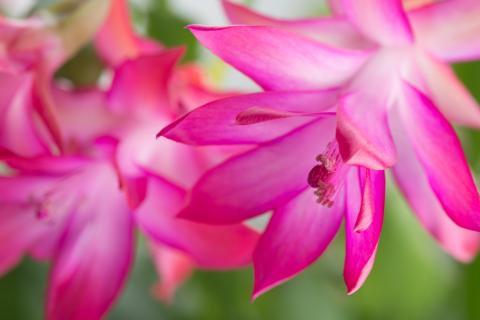The Christmas cactus conundrum
Granny Gertrude’s Garden
Gertrude Weatherall
The Christmas season is upon us. Christmas trees, live garland, wreaths and other evergreens deck our halls. To make our homes more inviting we introduce the smells of the season: cinnamon, spruce, apple, orange, clove and a plethora of other spices. Poinsettias, rosemary and Christmas cacti are strategically placed for just the right pop of color. Where would our holidays be without the enhancement of plants?
For now, I would like to focus on the Christmas cactus and the conundrum associated with it.
Often, I hear folks talking about their Christmas cactus blooming at Halloween or Thanksgiving. Some bloom as late as Easter. Few bloom in time for Christmas. They were in bloom when they were purchased during the previous Christmas season. Why did my perfectly healthy Christmas cactus bloom during Halloween this year? To answer this question, I must do a bit of debunking and a little explaining.
First, let me start by saying most Christmas cacti are not Christmas cacti at all. To explain this I need to use a bit of Latin, so hang with me. A group of plants called Christmas cactus include: Schlumbergera bridgesii (actually Christmas cactus), Schlumbergera truncata (actually Thanksgiving cactus) and Rhipsalidopsis gaertunerii (actually Easter cactus).
Once upon a time, these plants could all be identified by the shape of their leaves. In our quest to get new colors there has been lots of hybridization between the different species. Plants now exist that are interspecies crosses. Unfortunately, the shape of the leaves is no longer a reliable means to identify which type of cactus one may have. Since each type of cactus had a different bloom time, and this characteristic has been passed to the offspring, only the breeders really know when they will bloom.
Christmas cacti initiate their blooming cycle based on the amount of daylight and dark hours they receive. Many home gardeners often put the cacti outdoors in the summer and bring them inside during the late fall prior to the first frost. This results in less light and often the plants begin budding within weeks. This is because they are photo periodic, meaning that changes in light trigger the plants blooming cycle. Commercial growers manipulate this phenomenon to force the entire group of assorted cacti species into blooming. This is done by carefully controlling the lighting in a controlled growing environment.
Perhaps a better way to refer to them would be to call them all holiday cacti. They are beautiful any time they are in bloom and make beautiful houseplants even when not in bloom. They are easy to care for and with just a minimal amount of care, they will thrive for decades.
When potting or re-potting Christmas cacti, use a quality mix potting media with a high humus content. Place your plants in a container with excellent drainage holes, add some pea gravel to the bottom, about an inch deep, to improve drainage. Keep the plants in the mid-60-degree range. East-facing windows are the best.
If moving outdoors during the summer do so in a shaded area. Keep watered, the soil should always be slightly damp to the touch. When in bud, fertilize every couple of weeks with a fertilizer high in potassium. Transplant every three years or so. Propagation is easy. Simply place a leaf vertically in moist soil and in no time at all you will have a new plant. Most insect problems are easily controlled by using insecticidal soap.
Look for Christmas cacti this time of the year. Sure, they may not bloom for you next Christmas, but they usually bloom at some point. They are inexpensive, readily available, easy to care for and make beautiful house plants year-round. Colors include: red, shades of pink and orange, white, two tones, and even the new yellow ones which really look off white with pink shading.
Very often vendors drastically reduce the cost of unsold Christmas cacti post season. For a fraction of the cost, they can be picked up and make exceptional houseplants. So, why not pick one up today?
With a bit of care you will be befumbled for years to come. You just never know when that darned Christmas cactus may bloom.
- Log in to post comments
